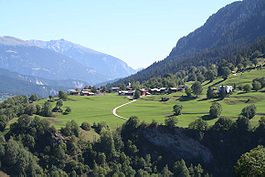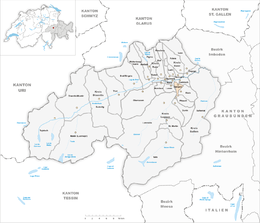Sevgein
| Sevgein | ||
|---|---|---|
| Former municipality of Switzerland | ||
 |
||
|
||
| Coordinates: 46°45′N 9°13′E / 46.750°N 9.217°ECoordinates: 46°45′N 9°13′E / 46.750°N 9.217°E | ||
| Country | Switzerland | |
| Canton | Graubünden | |
| District | Surselva | |
| Area | ||
| • Total | 4.60 km2 (1.78 sq mi) | |
| Elevation | 861 m (2,825 ft) | |
| Population (Dec 2011) | ||
| • Total | 198 | |
| • Density | 43/km2 (110/sq mi) | |
| Postal code | 7127 | |
| SFOS number | 3584 | |
| Surrounded by | Castrisch, Cumbel, Ilanz, Luven, Pitasch, Riein | |
| Website | SFSO statistics |
|
Sevgein is a former municipality in the district of Surselva in the Swiss canton of Graubünden. On 1 January 2014 the former municipalities of Sevgein, Castrisch, Ilanz, Ladir, Luven, Pitasch, Riein, Ruschein, Schnaus, Duvin, Pigniu, Rueun and Siat merged into the new municipality of Ilanz/Glion.
Sevgein is first mentioned about 840 as Soviene.
Before the merger, Sevgein had a total area of 4.6 km2 (1.8 sq mi). Of this area, 39.6% is used for agricultural purposes, while 51.5% is forested. Of the rest of the land, 5.2% is settled (buildings or roads) and the remainder (3.7%) is non-productive (rivers, glaciers or mountains).
The former municipality is located in the Ilanz sub-district of the Surselva district. It is located on a terrace in the southern Vorderrhein valley. It consists of the village of Sevgein and the settlement of Isla near Ilanz. Until 1943 Sevgein was known by its German name as Seewis im Oberland.
Sevgein had a population (as of 2011) of 198. As of 2008[update], 1.4% of the population was made up of foreign nationals. Over the last 10 years the population has grown at a rate of 8.5%. Most of the population (as of 2000[update]) speaks Romansh (54.6%), with German being second most common (44.9%) and Portuguese being third ( 0.5%).
...
Wikipedia




